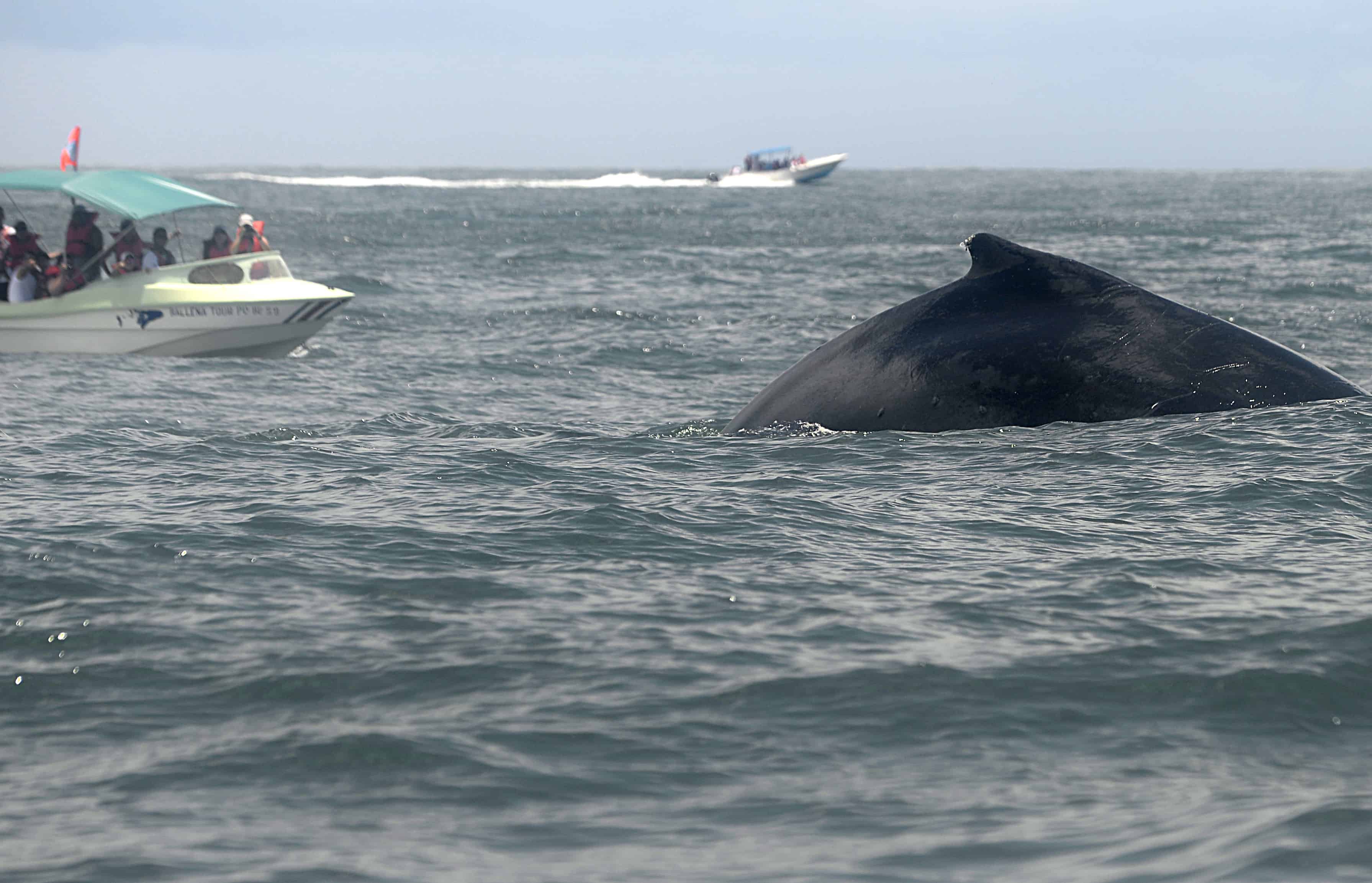All was tranquil on the rolling, open sea as guests aboard a small skiff peered in all directions. A few brown booby birds soared just above the emerald green water, and just a few fluffy clouds hung in the light blue sky. Just when those aboard the boat were being lulled into a reverie, forgetting what they had even come to see, off in the distance, an expulsion of water shot into the air.
The passengers cried out, and the captain directed the boat toward the spray, which had come from the blowhole of a female humpback whale. When the boat got close enough to the surfacing whale, its bumpy face, smooth dorsal fin and distinctive, white-tipped tail took turns coming into view. “She’s incredible,” one man said, barely able to believe his eyes. There were about a dozen people on board, and every one of them was snapping photos. It only got better when the boat captain pointed out that she was nursing her calf, which was also gigantic.
It was all part of the yearly Whale and Dolphin Festival held off the southern Pacific coast of Uvita, and this was the festival’s fifth iteration. The celebration also included fairgrounds with rides and vendor stalls, as well as nighttime concerts featuring some of Costa Rica’s top artists. But the whales are the big draw, as this is the best time of year to see them.
The whale tours actually operate year round, said boat pilot Antonio Hernández, who is originally from Limón, on the Caribbean coast, and has been doing the job for 25 years. Although visitors don’t often see breaches or tail-exposing dives, sometimes they do get lucky, Hernández said.
A two-hour tour costs $40 per person, with longer, more expensive tours offering trips to nearby islands. Though the tour includes the possibility of seeing dolphins, they are much less common, according to Hernández.
On Saturday night, one of the most famous Costa Rican rock bands, Gandhi, performed a free concert on the beach. Composed of fanatic teenagers, older Costa Ricans and families with small children, the crowd thoroughly appreciated the show, temporarily neglecting a series of booths near the stage offering gifts, smoothies, churros and falafel sandwiches.
During the daytime activities, a nonprofit group focusing on protecting marine life, the Keto Foundation, participated.
“The festival is a way to get people to come into the area to teach them about the biology, ecology and conservation of whales,” David Palacios from the Keto Foundation said in a phone interview.
Palacios has been studying whales in Costa Rica for 11 years. The humpbacks seen during the September whale festival are from a group that has traveled from their feeding grounds near Antarctica, he said, a one-way journey of approximately 8,000 kilometers. The whales use the tropical waters for breeding and raising their calves, according to Palacios, then they return to Anarctica to feed. This group hung around in Uvita from July to October.
A second group is popular in Uvita from March to April, having migrated from feeding grounds along California and Oregon.
Palacios said the calves born near Uvita will experience substantial growth rates, adding 40 kilograms of mass per day, and two to three centimeters in length. The humpbacks will eventually grow to 25-40 tons and 14-17 meters in length. The rapid expansion comes from the mother feeding her calf an average of 200 liters of fatty milk per day.
The most famous characteristic of humpbacks is the male’s song. These songs can reach up to 20 minutes in length and have been an insight into the humpback’s intelligence.
“Studies suggest they make the song to attract females and to announce to other males,” Palacios said.
Palacios further explained that the songs serve an important role in defining territories for males in open water, where no natural borders, such as shores, exist to separate the competitive males.
These lengthy songs will change over the course of a season, according to Palacios, with whales improvising the ends of songs, and often adopting sounds they have heard over a season. As Palacios explained, this phenomenon can be seen on a larger scale, because humpbacks traveling in Africa will have a different song dialect than whales traveling the Pacific coast of America.
When songs fail, the males fight, hitting each other with their fins and backs, according to Palacios.
Palacios said that while the days of serious commercial fishing are over for humpbacks, many threats still remain. Illegal fishing continues, and other sea commerce indirectly affects whales.
Heavy shipping traffic collides with whales, said Palacios. For example, blue whales have collided with ships around Sri Lanka. Net fishing and other forms of trawlers can ensnare dolphins and whales. Costa Rican courts recently banned new licenses on shrimp net fishing, citing the entanglement and harm caused to numerous marine species.
Palacios noted that for humpbacks, even the noise of the shipping traffic can create problems, blocking out their ability to hear other whales. Palacios said that whales often have a strong loyalty towards certain locations but also feel the need to live and travel in the company of others.
“Because of this, it’s really important for countries to follow the guidelines for conservation,” Palacios said.






